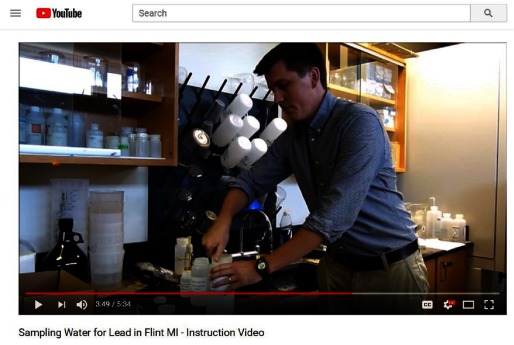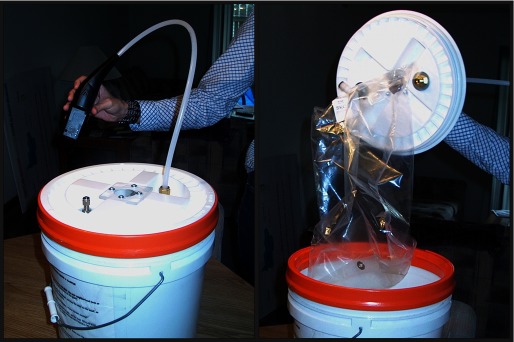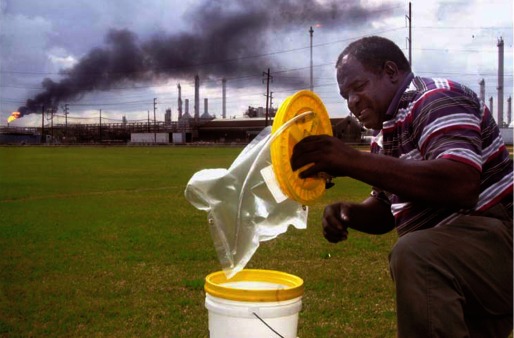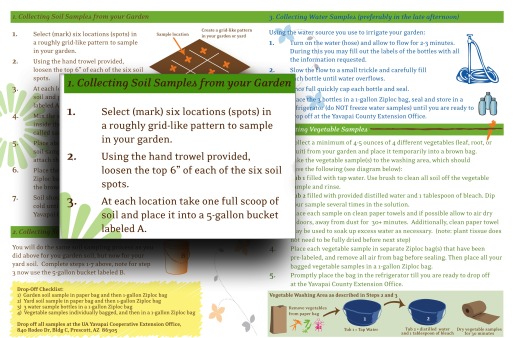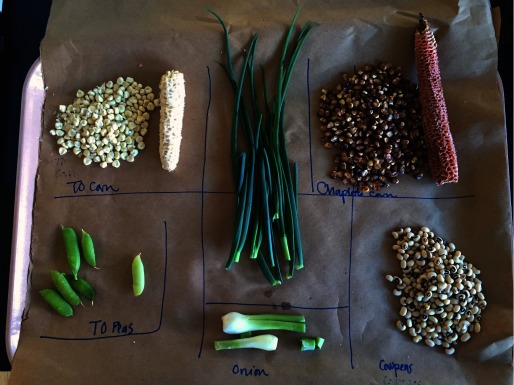Mónica Ramírez-Andreotta sat on a folding chair holding a notebook and pen in the Humboldt Elementary School gym. It was August 2008, and Leah Butler, a project manager with the U.S. Environmental Protection Agency (EPA), was leading a public meeting about the recent designation of a Superfund site within the small community of Dewey-Humboldt, Arizona. The agency had determined that more than of mine tailings left behind by the Iron King Mine and the Humboldt Smelter posed a health risk to the residents.1
Butler explained to the audience that wind and water erosion could carry the hazardous waste, which contained arsenic, lead, and other contaminants, from the former industrial properties into Dewey-Humboldt neighborhoods, potentially contaminating residents’ water, soil, and air. She then outlined what the agency’s cleanup efforts would entail and how the community would be involved.2
At the conclusion of the presentation, residents’ hands shot up, and Ramírez-Andreotta scribbled down their questions. Then a doctoral student at the University of Arizona, she was also employed as the research translation coordinator for the University of Arizona Superfund Research Program. The program, which is funded by the National Institute of Environmental Health Sciences, promotes multidisciplinary research on human health and environmental issues related to hazardous substances. Ramírez-Andreotta’s job that night was to listen to community members’ concerns and let them know about the program.
One question she heard more than once from residents struck her as particularly interesting: Was it safe to eat the vegetables they grew in their gardens?
After the meeting, Ramírez-Andreotta approached some of the audience members, introduced herself, and made a proposal about their gardening concerns. “I cannot give you a specific answer at this point in time,” she said. “But are you interested in working together to do the research and come up with the answer?”
There is a long history of laypeople participating in scientific research, from Charles Wilson Peale’s efforts in the 18th century using public donations to create the first U.S. natural history museum3 to 20th-century homemaker Lois Gibbs canvassing her neighbors in the Love Canal community to record their children’s birth defects.4
Still, it has only been in the past few decades, since the term “citizen science” was coined in the mid-1990s,5 that the practice has been recognized formally by the scientific community.6 Although some investigators remain wary of citizen science6 (and some citizens in environmentally contested areas are skeptical that scientists will investigate their true concerns), an increasing number of studies have reaped benefits from community involvement.7
Citizen science projects also have the potential to democratize science by exposing a greater and more diverse section of the population to the scientific process. This is especially true in the environmental health research realm because a disproportionately high number of people of color and of low income—who also are underrepresented in the research community—live near environmentally compromised spaces.8
“I like to stress that now we live in a time where your ZIP code may be more important than your genetic code,” Ramírez-Andreotta says. “Where you live, your proximity to waste, your socioeconomic status, and your physical environment can, in some cases, mean more in terms of your health than the genetic makeup that you were born with.”
Citizen science projects involving environmental health research can be challenging for both investigators and residents in affected communities however. Some scientists, for instance, may worry they will be labeled environmental activists and their scientific neutrality compromised if they help a group of concerned citizens to investigate potential environmental contamination. Others may wonder if they can obtain reliable data from people who have no formal scientific training. On the flipside, residents may become frustrated if their health concerns are not taken seriously and if they are not included equitably in decision making and data sharing while the investigation is ongoing.9
Concerns and Confidence
Marc Edwards, a professor at Virginia Polytechnic Institute and State University, stood on the lawn of City Hall at Flint, Michigan, at a press conference. He held two small plastic bottles, one filled with orange water. Next to him was LeeAnne Walters, mother of four, who several months earlier had sent Edwards 30 samples of her tap water. Tests showed the water to have high levels of lead—one sample had more than 1,300 times the World Health Organization’s maximum acceptable limit of for lead in water. “It was the worst I’ve seen in 25 years,” Edwards says. He estimated at the press conference that 5,000 Flint homes had tap water lead levels that exceeded .
After he measured the lead in Walters’s water, Edwards and his graduate students distributed water test kits to Flint residents. His students also made a video10 explaining how to take samples of drinking water, and local community groups and representatives of the American Civil Liberties Union held training sessions in the basement of a local church.
Graduate students and researchers from Virginia Tech assembled and shipped 300 water testing kits for Flint citizen scientists. The kits included labeled bottles and an instruction sheet for sampling tap water. Image: © Marc Edwards/Virginia Tech.
Edwards says he was confident that the Flint residents could collect the water samples properly. His assurance stemmed from several factors. For one, local water utilities already routinely rely on citizens to send in their own samples to determine compliance with the Lead and Copper Rule, which is enforced by the U.S. Environmental Protection Agency.11 In addition, his previous experience of working with residents of Washington, DC, whose water had been found to have high lead levels years earlier, showed him that most laypeople who suspect pollution in their water are, as he puts it, “very careful and more concerned than most scientists about making a sampling mistake.” And finally, he points out that the U.S. EPA protocol allows for some mistakes and that his team looks for sampling anomalies.
Under the Lead and Copper Rule, the agency throws out the 9 samples with the highest concentrations of lead from every 100 collected. That is because, although there is no maximum contaminant level (MCL) for lead, utilities must take corrective action if more than 10% of households sampled have concentrations of the metal above the action level set by the U.S. EPA.11
The Virginia Tech students also produced an instructional video (https://www.youtube.com/watch?v=dEQDaPws2xk) to show how to correctly collect tap water samples using the kits. Correct sampling is critical to accurately capture how much lead residents may be ingesting through drinking water. Image: Courtesy of YouTube.
Despite Edwards’s confidence, sampling error in citizen science projects is something that concerns many scientists. In a 2014 study, investigators Hauke Riesch and Clive Potter conducted qualitative interviews with scientists participating with the Open Air Laboratories network, a citizen science network in the United Kingdom. They found that data quality was “a clear area of worry for the majority of interviewees.”6
To combat that concern, the scientists interviewed by Riesch and Potter employed a range of methods, from extensive training and supervision, to cross-checking the data with their own observations and/or data from previously published studies, to simplifying research questions and the data collection protocols as much as possible. “Needless to say,” they wrote, “the issues about data quality were in the end solved to the satisfaction of the participating scientists and therefore represented no stumbling block for the enterprise as a whole.”6
Ramírez-Andreotta followed a similar protocol in Dewey-Humboldt. She held extensive training sessions with the residents and conducted a controlled greenhouse study growing similar vegetables in three different soil types.12 She also randomly selected households where she collected her own samples to compare against the residents’ samples. She was exceedingly careful, she says, “because I knew if we observed a contaminant of concern at an elevated concentration, that one of the first things others might want to challenge is the methodology; they’d say, ‘Oh, they did not know how to collect the samples.’”13
Finding Common Ground
So what does it take for a regulatory agency to take the work of citizen scientists seriously enough to influence research agendas, affect policy, or change scientific standards of proof? Gwen Ottinger, an associate professor in Drexel University’s Center for Science, Technology and Society, has investigated that very question. Beginning in 2001 she looked at whether citizen science projects conducted by “fenceline” communities—those located adjacent to oil refineries and chemical manufacturing plants—were able to influence state and federal regulatory agencies. The focus of her study was the community of New Sarpy, Louisiana, which adjoins a Shell Chemical plant.14
Residents of New Sarpy worried that their health was being harmed by pollution spikes during events such as gas flaring and venting, plant start-ups, malfunctions, and accidents.15 They used “bucket sampling,” an inexpensive method for grabbing air samples at discrete points in time, to provide evidence that their industrial neighbors occasionally released high levels of dangerous chemicals into the air. As the name suggests, air is drawn into a nonreactive plastic bag inside a bucket, then the bag’s valve is closed, and the bag is shipped overnight to a laboratory for analysis.
Regulatory clean air standards are designed to reflect pollution measurements averaged over longer periods of time. For instance, regulators use sampling instruments that may sample continuously over 24 hours, every sixth day.14 This mixes air collected during pollution peaks with the relatively clean air present during the rest of the sampling period. The results, Ottinger wrote in a 2010 article, render “pollution spikes invisible in the process of comparing air quality measurements to air quality standards.”14
An early bucket sampler used by the Louisiana Bucket Brigade employed a hand-held vacuum cleaner to pump the air out of a five-gallon plastic container, then draw ambient air into through a stainless steel inlet to a nonreactive plastic bag. Image: © Gwen Ottinger/Drexel University.
Because bucket sampling does not align with federal monitoring standards, Ottinger says the validity of the citizens’ results was questioned by federal and state scientists. This presented an impasse of sorts, she says, with the scientists claiming the data were not legitimate and the citizens claiming the standards do not address the “right questions.”14 She believes this difference of views toward citizen science—one that is “scientific authority-driven” citizen science and the other “social movement-based” citizen science, needs to be addressed if the true potential of citizen science is ever to be fulfilled.
“For people in the environmental justice movement who are trying to make a change, science is a mixed bag,” Ottinger says, “because a lot of versions of science tell them you’re not experiencing what you’re experiencing, whereas the environmental justice citizen scientists want to ask a research question that makes visible what they know from experience… . It’s probably more of a spectrum than two poles, but they are important distinctions.”
A citizen scientist collects air samples near the Norco Shell Chemical Plant. The samples provided evidence that the plant occasionally released high levels of pollutants that were not reflected in regulatory measurements averaged over longer periods of time. Image: © Louisiana Bucket Brigade.
What is the solution? In the case of the Louisiana bucket brigade, some consensus was reached because the laboratory that analyzed the citizens’ samples used the same method that the U.S. EPA uses to analyze its own samples.16 That made the two sets of results directly comparable. In addition, the activists had used a U.S. EPA laboratory in California to conduct quality assurance testing on the use of the bucket sampler. Thus, they could argue that they were using a “U.S. EPA-approved” monitoring method. This allowed the bucket data to be received with some credibility among the research scientists.17
Another solution is for activists to work to change the air quality standards. “Standards are meant to be ‘invisible’ so we do not have to think about them,” Ottinger says. It takes time and effort to lobby for change, and so it is not necessarily a place where social movement groups would want to spend their limited resources.14 Nevertheless, she says, citizen scientists may have to get deeper into the weeds and figure out how National Ambient Air Quality Standards are set and how they can make their voices heard when the standards are periodically reviewed. Anytime such a review is set to take place, there is a science policy workshop to gather input from both the scientific community and the public regarding policy-relevant issues and questions that can help inform the review.18
Overall, Ottinger believes bucket testing and other citizen science pollution monitoring projects are pushing the U.S. EPA to be more proactive in finding methods to help citizens and the agency work together. She points to the U.S. EPA’s new website, the Air Sensor Toolbox for Citizen Scientists, Researchers, and Developers,19 which was designed to help members of the public choose from the plethora of low-cost sensors now available to conduct air quality monitoring. The site also provides information on funding, training, and pilot studies for citizen scientists.19
At a 2015 workshop where community scientists received training in the use of the U.S. EPA’s Air Sensor Toolbox,19 agency scientists told the attendees that using such tools would make it easier for the agency to act on the data they gather. “They said if you want [regulators] to take your data seriously, you need to have them involved from the very beginning, consult with them, tell them what is coming, how you did it,” Ottinger recalls.
Although a tool that helps citizens and regulatory scientists align their goals makes sense, it is still unlikely that even this will erase all the debate between lay and regulatory scientists, Ottinger says. “The rejoinder from some in the audience was, ‘Well, wait a minute, we did all that, and it still did not work for us, because you did not like what you were seeing in the data.’”
Agency scientists may fear that citizen scientists have undertaken data collection with a biased mindset—for instance, convinced that a pollutant is causing health problems—which could result in skewed sampling. Ottinger, however, argues that citizens understand that any data they collect will be carefully scrutinized by agency scientists for evidence of problems. So the citizens have a strong motivation to collect high-quality data in a nonbiased way, in addition to the intrinsic motivation of protecting their health and families, says Ramírez-Andreotta.
Despite concerns, the U.S. EPA is investigating the possibilities of citizen science. “Data quality is always a priority when measuring air pollution, and EPA has well-defined data collection methods and guidelines to ensure that the data the agency uses in regulatory decisions is of the highest quality,” says an agency spokesperson who requested anonymity per agency policy. “Engaging local, state, or federal environmental agencies in the early planning of a citizen science project will help in determining the data quality required for intended applications.”
At the end of 2016 an advisory council established by the U.S. EPA urged the agency to “embrace citizen science” and recommended several actions the agency could take to maximize citizen science and integrate it into its work. These included embracing citizen science as a core tenet of environmental protection; dedicating funding for citizen science for communities, partners, and the agency; enabling the use of citizen science data at the agency; and integrating citizen science into the full range of work at the U.S. EPA.20
Co-creating Citizen Science
In 2004, Rose Eitemiller, a resident of Dewey-Humboldt, bought a newly constructed house on Sweet Pea Lane, near the Humboldt smelter. Eitemiller’s real estate agent had assured her the house could not have been built if the land were contaminated. A few years later, though, after she and her husband found debris in their yard connected to the smelter, Eitemiller called the U.S. EPA project manager who was analyzing the mine tailing site.
“I said, ‘I am wondering if we’re contaminated, too,’ and she said, ‘We haven’t even thought about looking over there,’ and I said, ‘You are kidding!’” recalls Eitemiller. She later had her young son tested, with the results showing he had elevated levels of arsenic in his urine that exceeding the 50th percentile for his age range. The U.S. EPA eventually included the smelter in its Superfund listing, and removed and replaced about (2 ft) of contaminated soil in most of the yards on Eitemiller’s street.21
Eitemiller’s experiences align with Ramírez-Andreotta’s notion that residents who live near a hazardous waste site are knowledgeable about the site and intrinsically motivated to learn about the potential negative ecological and health outcomes posed by the site. This makes them experts in their own right, she says, and a group worth listening to and working alongside.
“When you’re working with families living near contamination, they have a great deal of insight and important viewpoints,” she says. “They’re the ones taking the pictures of the mine tailing waste blowing off-site on windy days. They’re the ones who are perhaps distressed and experiencing illness.”
After attending that first U.S. EPA meeting in August 2008, Ramírez-Andreotti continued to return to Dewey-Humboldt and talk to residents. Eventually she obtained a U.S. EPA grant to conduct a citizen science project to characterize the uptake of arsenic by vegetables commonly grown in the Dewey-Humboldt community. She named the project Gardenroots: The Dewey-Humboldt Arizona Garden Project.13
From the start, Ramírez-Andreotta was determined to make Gardenroots as equitable as possible by having the residents decide the research question, design how the experiment would be conducted on their properties, take the samples, and learn how to interpret the results. This approach is called “co-created citizen science.”22
As part of the Gardenroots project, researchers developed an instruction manual (https://superfund.arizona.edu/sites/superfund.arizona.edu/files/photofiles/gardenroots_instructional_manual.pdf) to help participants properly collect soil, water, and vegetable samples from their homes. Image: © University of Arizona.
Community members, in addition to providing samples of irrigation water and soil, collected vegetables that they grew. The garden crops spanned the major plant families12 and ultimately provided an invaluable data set, Ramírez-Andreotta says. By taking a public participatory approach, she says, the study was more applicable to the community, based upon what they actually grew and ate, and was thus fundamentally aligned with their research questions.
After analyzing residents’ vegetable, soil, and water samples for arsenic, Ramírez-Andreotta faced the challenge of communicating the probability of developing cancer from exposure to the arsenic levels within the various media. Late one night, she sat in front of her computer, designing customized booklets that she planned to give each resident listing the contamination levels in their soil, water, and vegetables. But how to explain their risk?
Each Gardenroots participant received the results of the arsenic testing on his or her homegrown vegetables. Afterward, many indicated they planned to take new precautions to avoid arsenic exposure through gardening. Image: © Mónica Ramírez-Andreotta/University of Arizona.
The U.S. EPA uses a risk assessment threshold of 1 cancer case in 10,000 as a basis for determining whether to clean up a Superfund site.23 If risk posed by a given environmental pollutant falls between 1 in 10,000 and 1 in 1 million cases, this is deemed an acceptable risk.23 Ramírez-Andreotta initially decided to frame the residents’ results in terms of risk that would fall right in the middle of that range; she would give residents a chart listing how much of each vegetable they could eat from their gardens before hitting a risk level of 1 in 100,000.
But then she had an “aha” moment. “I realized I had chosen their risk level for them!” she says. She went back to her computer and changed each booklet, making charts with three risk categories: 1 in 10,000, 1 in 100,000, and 1 in 1 million so residents could decide on their own how much they felt comfortable eating. She also gave them the raw data for their individual samples of vegetables, soil, and water.
Afterward, Ramírez-Andreotta said she was pleased that residents continued to garden but changed some of their practices. For instance, incidental soil ingestion and drinking water were estimated to pose a greater risk of arsenic exposure than eating the vegetables themselves, and a survey of the residents after the data-sharing event indicated they planned to take precautions to avoid these exposures. These included avoiding gardening on windy days, washing their hands after gardening, and storing gardening tools outdoors.24 Some also recalculated their risk exposure because they knew there were certain vegetables they would not eat as often.
The project had also uncovered an unforeseen problem. A number of residents had water samples whose arsenic concentrations tested above the U.S. EPA’s MCL of (or ppb). Among these were residents on town water, whose exceedances triggered a state notice of violation and a fine to the utility. Ramírez-Andreotta reported these findings to the U.S. EPA and the Arizona Department of Environmental Quality. However, the fact that the arsenic occurred naturally from the region’s geology made the contamination a state drinking water matter, not a Superfund matter. The U.S. EPA therefore had to delegate the issue to the Arizona department.
Ramírez-Andreotta says the U.S. EPA’s inability to get involved was frustrating to residents, who did not want to be exposed to arsenic through their drinking water whether it was there naturally or not. Still, she believes that as a result of Gardenroots the residents had increased their capacity for advocating for their best interests. Having their residential site-specific data was critical in addressing the MCL exceedance, and it provided the evidence needed to move the water company into compliance.
Citizen Concerns Change over Time
Ramírez-Andreotta and colleagues documented a shift in the concerns that Dewey-Humboldt residents expressed through the initial 5 years (2008–2013) of being listed as a Superfund site. Using U.S. EPA public meeting records, town council minutes, Gardenroots meeting accounts, newspaper stories, and U.S. EPA factsheets mailed to residents, she and her coauthors observed that community members moved from a passive position of absorbing information to an action-oriented position of applying scientific knowledge to protect themselves.25 The shift in residents’ outlooks from passive to active, Ramírez-Andreotta believes, occurred in part as a result of the community’s engagement in research with the University of Arizona Superfund Research Program, which provided a platform for free-choice learning.
The U.S. EPA spokesperson says the agency believes it is critical to involve communities in the entire Superfund process. “Communities play a key role in informing EPA of how they want to be engaged in the process,” says the spokesperson. “In turn, EPA tailors its outreach to meet community needs, offering a wide range of opportunities for communities to learn about the science and health issues related to cleaning up Superfund sites.”
Ramírez-Andreotta recommends that the U.S. EPA work more to involve residents in the Superfund process beyond an initial typically one-time survey. She says residents can be involved during the remedial investigation that the agency conducts when a site is placed on the National Priorities List for cleanup. “Involving the affected communities via community-engaged research and participation in environmental projects during the USEPA’s Superfund management is critical,” Ramírez-Andreotta wrote in a 2016 article.25 “It can lead to improvements in one’s knowledge and awareness, sense of control and ability to make informed decisions and take measures to mitigate exposures.”
Biography
Nancy Averett writes about science and the environment from Cincinnati, Ohio. Her work has been published in Pacific Standard, Audubon, Discover, E/The Environmental Magazine, and a variety of other publications.
References
- 1.U.S. EPA (U.S. Environmental Protection Agency). 2017. Iron King Mine and Humboldt Smelter Description and History [website]. Washington, DC:U.S. Environmental Protection Agency; https://yosemite.epa.gov/r9/sfund/r9sfdocw.nsf/ViewByEPAID/az0000309013 [accessed 5 September 2017]. [Google Scholar]
- 2.Tone S. 2008. Two chances to hear EPA’s update on Iron King. Prescott Valley Tribune, online edition, News section, 14 August 2008. http://www.pvtrib.com/news/2008/aug/14/two-chances-to-hear-epas-update-on-iron-king-site/ [accessed 5 September 2017].
- 3.Diethorn K. 2017. Peale’s Philadelphia Museum [website]. http://philadelphiaencyclopedia.org/archive/peales-philadelphia-museum/ [accessed 5 September 2017].
- 4.Yerman MG. 2014. Lois Gibbs: ‘The Government Wouldn’t Help Me, So I Decided to Do It Myself.’ Huffington Post, The Blog section, 22 April 2014. http://www.huffingtonpost.com/marcia-g-yerman/the-government-wouldnt-he_b_5188348.html [accessed 5 September 2017].
- 5.Irwin A. 1995. Citizen Science: A Study of People, Expertise and Sustainable Development. New York, NY:Psychology Press. [Google Scholar]
- 6.Riesch H, Potter C. 2013. Citizen science as seen by scientists: methodological, epistemological and ethical dimensions. Public Underst Sci 23(1):107–120, PMID: 23982281, 10.1177/0963662513497324. [DOI] [PubMed] [Google Scholar]
- 7.Nature. 2015. Rise of the citizen scientist [editorial]. Nature 524(7565):265, PMID: 26289171, 10.1038/524265a [DOI] [PubMed] [Google Scholar]
- 8.Soleri D, Long JW, Ramirez-Andreotta MD, Eitemiller R, Pandya R. 2016. Finding pathways to more equitable and meaningful public-scientist partnerships. Citiz Sci Theory Pract 1(1):9, 10.5334/cstp.46. [DOI] [Google Scholar]
- 9.Ramirez-Andreotta MD, Brusseau ML, Artiola JF, Maier RM, Gandolfi AJ. 2014. Environmental Research Translation: enhancing interactions with communities at contaminated sites. Sci Total Environ 497-498:651–664, PMID: 25173762, 10.1016/j.scitotenv.2014.08.021. [DOI] [PMC free article] [PubMed] [Google Scholar]
- 10.American Civil Liberties Union of Michigan. 2016. Here’s to Flint [video]. Detroit, MI:American Civil Liberties Union of Michigan; http://www.aclumich.org/herestoflint [accessed 5 September 2017]. [Google Scholar]
- 11.U.S. EPA. 2017. Drinking Water Requirements for States and Public Water Systems. Lead and Copper Rule [website]. https://www.epa.gov/dwreginfo/lead-and-copper-rule [accessed 5 September 2017].
- 12.Ramirez-Andreotta MD, Brusseau ML, Artiola JF, Maier RM. 2013. A greenhouse and field-based study to determine the accumulation of arsenic in common homegrown vegetables grown in mining-affected soils. Sci Total Environ 443:299–306, PMID: 23201696, 10.1016/j.scitotenv.2012.10.095. [DOI] [PMC free article] [PubMed] [Google Scholar]
- 13.Ramírez-Andreotta M. 2016. Cultivating Citizen Science to Reduce Environmental Risks [presentation, 31 October 2016. Presented at ScienceWriters 2016, 28 October–1 November 2016, San Antonio, TX:National Association of Science Writers. [Google Scholar]
- 14.Ottinger G. 2010. Buckets of resistance: standards and the effectiveness of citizen science. Sci Technol Human Values 35(2):244–270, 10.1177/0162243909337121. [DOI] [Google Scholar]
- 15.Louisiana Bucket Brigade. 2015. Louisiana Bucket Brigade [website]. http://www.labucketbrigade.org/content/bucket [accessed 5 September 2017].
- 16.U.S. EPA. 1999. Air Method, Toxic Organics-15 (TO-15): Compendium of Methods for the Determination of Toxic Organic Compounds in Ambient Air, Second Edition: Determination of Volatile Organic Compounds (VOCs) in Air Collected in Specially-Prepared Canisters and Analyzed by Gas Chromatography/Mass Spectrometry (GC/MS). EPA 625/R-96/010b. Washington, DC:U.S: Environmental Protection Agency; https://www.epa.gov/homeland-security-research/epa-air-method-toxic-organics-15-15-determination-volatile-organic [accessed 5 September 2017]. [Google Scholar]
- 17.Frickel S, Gibbon S, Howard J, Kempner J, Ottinger G, Hess DJ. 2010. Undone science: charting social movement and civil society challenges to research agenda setting. Sci Technol Human Values 35(4):444–473, 10.1177/0162243909345836. [DOI] [PMC free article] [PubMed] [Google Scholar]
- 18.U.S. EPA. 2016. Process of Reviewing the National Ambient Air Quality Standards [website]. https://www.epa.gov/criteria-air-pollutants/process-reviewing-national-ambient-air-quality-standards [accessed 5 September 2017].
- 19.U.S. EPA. 2017. Air Sensor Toolbox for Citizen Scientists, Researchers and Developers [website]. https://www.epa.gov/air-sensor-toolbox [accessed 5 September 2017].
- 20.National Advisory Council for Environmental Policy and Technology. 2016. Environmental Protection Belongs to the Public: A Vision for Citizen Science at EPA. EPA 219-R-16-001. https://www.epa.gov/faca/nacept-2016-report-environmental-protection-belongs-public-vision-citizen-science-epa [accessed 5 September 2017].
- 21.Tone S. 2015. Dewey-Humboldt’s Superfund site still poses risks and triggers frustration. Prescott Valley Tribune, online edition, 29 April 2015. https://www.pvtrib.com/news/2015/apr/29/dewey-humboldts-superfund-site-still-poses-risks-/ [accessed 5 September 2017].
- 22.Shirk JL, Ballard HL, Wilderman CC, Phillips T, Wiggins A, Jordan R, et al. 2012. Public participation in scientific research: a framework for deliberate design. Ecol Soc 17(2):29, 10.5751/ES-04705-170229. [DOI] [Google Scholar]
- 23.U.S. EPA. 1992. Understanding Superfund Risk Assessment. 9285.7-06FS. Washington, DC:U.S. Environmental Protection Agency. [Google Scholar]
- 24.University of Arizona. 2017. Simple Steps to Start Collecting: Tips [website]. https://gardenroots.arizona.edu/get-started#tips [accessed 5 September 2017].
- 25.Ramirez-Andreotta M, Lothrop N, Wilkinson ST, Root RA, Artiola JF, Klimecki W, et al. 2016. Analyzing patterns of community interest at a legacy mining waste site to assess and inform environmental health literacy efforts. J Environ Stud Sci 6(3):543–555, PMID: 27595054, 10.1007/s13412-015-0297-x. [DOI] [PMC free article] [PubMed] [Google Scholar]




